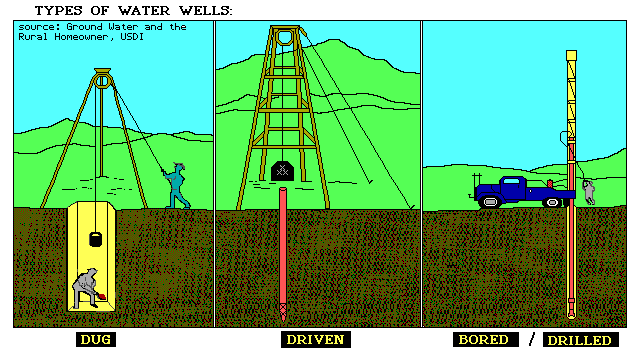 |
71 Water Street
Pembroke, MA 02359
|
781-826-9235 Telephone
781-826-4231 Fax
|
|
*** Serving New England Since 1952 ***
|
|
|
|
| G E N E R A L |
|
For a l ink to a more in-depth description (Perdue University):
Types Of Water Wells Wells and how they are constructed. (Agricultural & Biological Engineering Department (Purdue University))
|

|
| ^Top of page^ |
BASIC TYPES OF WELLS |
Water wells are classified according to the method used to construct them. There are four common types: dug, bored, driven and drilled. Dug, bored and driven wells are installed below the water table in soil, and are rarely deeper than 50 feet. Drilled wells typically are installed into solid rock under soil, and can reach depths as great as 1000 feet or more.
|
| ^Top of page^ |
DUG WELLS |
Dug wells are made by constructing a large hole into the earth to a depth greater than the ground water level. A reservoir is created by lining the walls of the hole with rocks, brick, wood, or concrete pipe to prevent cave-in. In some conditions the hole may be back filled with coarse gravel with a feed line installed. In this situation the gravel area acts as the reservoir. As long as ground water is present, a dug well will yield results. Water is extracted from the reservoir and replenished naturally from the aquifer. The well’s recharge and use capacities are directly related to the permeability of the soil into which the well is constructed . Dug wells are typically limited to a depth of 25’ - 30’, and are practical only when the water table is near the surface of the earth. Because of the dug well’s method of construction and shallow depth, contamination from surface drainage and sub surface seepage is common. In many areas dug wells are prohibited by law.
|
| ^Top of page^ |
BORED WELLS |
Bored wells are constructed by means of an auger which bores a cylindrical hole into the earth. After water is reached , soil samples are collected to determine the permeability of the soil. If a suitable permeable soil is encountered, a screen or filtering device is attached to a casing and lowered into the bore hole . The casing is driven or pushed to the desired depth. The well is developed, and water is extracted from the soil.
|
| ^Top of page^ |
DRIVEN WELLS |
Driven wells consist of a series of tightly coupled pipe lengths installed below the water table with a well point or screen at the lower end. The well point may be forced into the ground by a series of driven blows directed upon the pipe above it or telescoped into the well after the pipe is driven and soil samples are collected. The permeability of the soil is the determining factor for the feasibility of the well. Water is extracted directly from the soil.
|
| ^Top of page^ |
DRILLED WELLS |
Drilled wells typically are used in areas of geologically poor soil conditions. Drilled wells are commonly drilled by one of two methods: The first is known as “cable tool” or “percussion” method. It involves a machine that alternately lifts and drops a long chisel -shaped bit within the bore hole . The hole is deepened as the bit cuts and breaks the rock. A bailer is used to extract the cuttings as necessary. The second is called the “rotary well drilling” method. A rotating bit is fixed to the end or the drill pipe. The rotary action of this bit chews into the rock or other earth materials. Air or water is used to transport the cuttings to the surface. Water seeps into the bore hole through cracks or seams in the rock, and is extracted from the bore hole by means of a submersible pump typically installed to a depth greater than that of the water bearing seam.
|
|
|
|
|